#industrail
Explore tagged Tumblr posts
Photo

#Ricoh#GRII#industrail#brutalizm#brutalism#urban#urban photography#Street Photography#original photographers#photographers on tumblr#black and white#czarno białe#urban landscape
5 notes
·
View notes
Video
youtube
Oil-Electrical Hybrid storage system #powersupply #energy #industrail #s...
0 notes
Text
Experience the Power of Precision with UP Scales
At UP Scales, we are dedicated to providing cutting-edge weighing solutions that meet the diverse needs of industries across India. In this video, we showcase some of our flagship products:
1.) High-Capacity Electronic Weighbridge: Witness the precision of our 100-ton capacity electronic weighbridge with a remarkable 52-foot height, designed to handle the heaviest loads with ease and accuracy.
2.) Industrial Weighing Scales: Explore our range of robust industrial scales, including platform scales (capacities from 100kg to 5 tons) and crane scales (capacities from 3 tons to 20 tons), built for durability and reliability in demanding industrial environments.
Government-Certified Quality and Unwavering Support
UP Scales prioritizes quality and customer satisfaction. All our weighing solutions are:
1.) Government-Calibrated and Stamped: We ensure compliance with legal metrology standards by obtaining Government Calibration Verification Certificates and Stamping from the Legal Metrology Department for all our weighbridges, industrial scales, and other weighing instruments.
2.) Backed by a 1-Year Warranty: We offer a comprehensive 1-year on-site warranty on all our products, providing you with peace of mind and minimizing downtime.
Why Choose UP Scales?
1.) Unmatched Accuracy and Reliability: Experience the precision and durability of our expertly engineered weighing solutions.
2.) Comprehensive Range of Products: Find the perfect weighing solution for your specific needs from our extensive product catalog.
3.) Government-Certified Quality: Ensure compliance and accuracy with government-approved calibration and stamping.
Excellent Customer Support: Benefit from our expert technical support and after-sales service.
#IndustrialWeighingScale #PlatformScale #CraneScale #Weighbridge #GovernmentCalibration #Stamping #Accuracy #Reliability #UPScales
Contact us today at 9899008683 or visit our website https://buyweighingmachine.com/ to discuss your specific weighing needs.
#weighing scale#industrail scale#weighbridge#platform weighing scale#crane scale#calibration verification certificate#nabl certificate
0 notes
Text
Industrial Dampers: Key Features and Importance
Industrial dampers play a crucial role in various mechanical and HVAC (heating, ventilation, and air conditioning) systems. These devices help control airflow, maintain environmental conditions, and ensure safety in industrial settings.
Let’s delve into the basics of industrial dampers, their main features, and why they are so important.

Industrial Dampers
What Are Industrial Dampers?
Industrial dampers are mechanical devices used to regulate the flow of air and gases in industrial systems. They are commonly found in HVAC systems, power plants, manufacturing facilities, and any environment where controlling air movement is essential.
Key Features of Industrial Dampers
Airflow Regulation
The primary function of dampers used in industries is to regulate airflow. They can open, close, or partially obstruct ducts to control the volume of air passing through. This precise control allows for optimal environmental conditions, maintaining desired temperatures, humidity levels, and air quality in industrial settings. By adjusting the position of the damper blades, these devices ensure that air distribution is efficient and tailored to the specific needs of different areas within a facility.
Modular Design
Many dampers are designed with a modular structure, allowing for easy customization and expansion. This means that different components of the damper can be swapped or added based on specific requirements, making them versatile and adaptable to various applications.
Pressure Management
Dampers used in industries are capable of managing high-pressure environments. They can withstand and regulate air and gas flow even under significant pressure, ensuring the stability and safety of the system they are integrated into.
Corrosion Resistance
To withstand harsh industrial environments, dampers often come with corrosion-resistant coatings or are made from materials that resist rust and degradation. This feature extends the lifespan of the damper and reduces maintenance needs.
Noise Reduction
Some dampers are designed with noise reduction features. By controlling and directing airflow efficiently, they help minimize the noise generated by moving air or gases, contributing to a quieter and more comfortable working environment.
Fire and Smoke Control
In addition to standard airflow regulation, certain dampers are specifically designed to control fire and smoke. These dampers can automatically close in the event of a fire, preventing the spread of flames and smoke through ventilation systems, thereby enhancing the safety of the facility.
Types and Designs:
1. Butterfly Dampers:
These have a rotating disc to control airflow and are known for their simplicity and effectiveness.
2. Louver Dampers:
Composed of multiple blades, these dampers offer fine control over airflow and are ideal for ventilation systems.
Guillotine Dampers: Featuring a sliding blade, these dampers provide a tight seal and are used in applications where a complete shutoff is required.
Materials and Construction: Industrial dampers are built to withstand harsh conditions. Common materials include stainless steel, aluminum, and other robust alloys, ensuring durability and resistance to corrosion.
Actuation Mechanisms:
Manual: Operated by hand, suitable for systems that do not require frequent adjustments.
Automatic: Controlled by electric, pneumatic, or hydraulic actuators, allowing for precise and remote operation.
Sealing and Insulation: High-quality dampers feature effective sealing and insulation to prevent leaks and ensure efficient operation. This is particularly important in maintaining temperature control and reducing energy consumption.
Importance of Industrial Dampers
Temperature and Climate Control: In HVAC systems, dampers are essential for regulating indoor climate. They help maintain comfortable temperatures by controlling the amount of heated or cooled air distributed throughout a building.
Energy Efficiency: By precisely controlling airflow, dampers help optimize energy use. They prevent the waste of heated or cooled air, thus reducing energy bills and supporting environmental sustainability.
Safety: In industrial settings, dampers can act as safety devices. For example, they can shut off air supply in the event of a fire, preventing the spread of flames and smoke.
Process Control: In manufacturing and power generation, dampers help regulate conditions necessary for various processes. This ensures product quality and operational efficiency.
Ventilation: Effective ventilation is critical in industrial environments to remove hazardous fumes, dust, and other airborne contaminants. Dampers help manage ventilation systems, ensuring a safe and healthy workplace.
Conclusion
Industrial dampers are indispensable components in a wide range of applications. Their ability to control airflow, enhance energy efficiency, and contribute to safety makes them vital in industrial operations. Whether it’s maintaining a comfortable indoor climate or ensuring the smooth operation of industrial processes, the role of dampers cannot be overstated. Understanding their features and importance can help industries optimize their systems for better performance and sustainability.
0 notes
Text
Shielding Your Space: Exploring the Benefits of Anti-Radiation Doors
In an age where technology reigns supreme and electromagnetic radiation is ubiquitous, the need to safeguard ourselves from its potential harm has become paramount. Enter anti-radiation doors – a cutting-edge solution offered by companies like HIKOM International LLP – designed to provide protection and peace of mind in our modern living spaces.
The proliferation of electronic devices and wireless communication systems has led to a significant increase in electromagnetic radiation levels in our environment. While the effects of long-term exposure to such radiation are still being studied, concerns about its potential health risks have prompted individuals and businesses alike to seek out ways to mitigate its impact. This is where anti-radiation doors come into play.
So, what exactly are anti-radiation doors, and how do they work? Simply put, these doors are engineered to block or reduce the transmission of electromagnetic radiation, effectively creating a shielded barrier between the inside and outside of a building. This shielding is achieved through the use of specialized materials such as lead, steel, or other alloys that are capable of absorbing or reflecting electromagnetic waves.
One of the key benefits of anti-radiation doors is their ability to create a safer and healthier indoor environment. By minimizing the penetration of electromagnetic radiation from sources such as mobile phones, Wi-Fi routers, and power lines, these doors help reduce the potential risks associated with prolonged exposure. This is particularly important in spaces where sensitive equipment or individuals with heightened sensitivity to electromagnetic fields may be present, such as hospitals, laboratories, or residential buildings.
In addition to protecting occupants from electromagnetic radiation, anti-radiation doors also offer other advantages. For example, they can enhance the overall security of a building by providing an additional layer of protection against unauthorized access or forced entry. This is especially relevant for high-security facilities or areas where privacy and confidentiality are paramount.
Furthermore, anti-radiation doors can contribute to energy efficiency by improving insulation and reducing heat loss or gain. This can result in lower utility bills and a more comfortable indoor climate throughout the year. By investing in anti-radiation doors, property owners can not only safeguard their health but also enhance the value and sustainability of their buildings.
HIKOM International LLP is at the forefront of providing innovative anti-radiation door solutions to meet the diverse needs of its customers. With a commitment to quality, reliability, and customer satisfaction, HIKOM offers a range of customizable options to suit different applications and architectural styles. Whether it's a residential, commercial, or industrial project, HIKOM's team of experts works closely with clients to design and install anti-radiation doors that exceed expectations.
HIKOM's anti-radiation doors are manufactured using state-of-the-art techniques and materials, ensuring superior performance and durability. Rigorous testing and quality control measures are employed to guarantee that each door meets the highest standards of safety and effectiveness. From the initial consultation to the final installation, HIKOM's dedicated professionals provide comprehensive support and guidance every step of the way.
In conclusion, anti-radiation doors offer a host of benefits for those looking to shield their space from the harmful effects of electromagnetic radiation. From protecting health and enhancing security to improving energy efficiency and sustainability, these doors provide a holistic solution for modern living environments. With HIKOM International LLP leading the way in innovation and excellence, customers can trust that they are investing in the best anti-radiation door solutions available on the market.
0 notes
Text
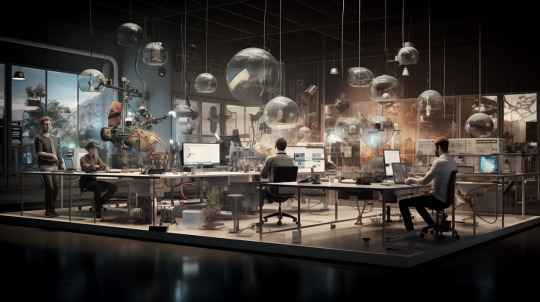
Revolutionizing Innovation: SteelNine's Cutting-Edge Industrial Design Services
In an era defined by rapid technological advancements and dynamic market demands, companies worldwide are seeking innovative solutions to stay ahead of the curve. One crucial aspect of this innovation is industrial design, a discipline that merges functionality with aesthetics to create products that not only meet user needs but also make a lasting impression. At the forefront of this revolution is SteelNine, a pioneering company that specializes in providing unparalleled Industrial Design Services.
The Essence of Industrial Design:
Industrial design is the process of integrating form and function to enhance the usability, aesthetics, and marketability of a product. It involves a meticulous blend of creativity, technical expertise, and an understanding of user behavior. SteelNine recognizes the significance of industrial design in shaping the success of products in various industries, from consumer electronics to automotive and beyond.
SteelNine's Commitment to Excellence:
As a leading player in the field, SteelNine stands out for its unwavering commitment to excellence. The company employs a team of highly skilled and experienced industrial designers who are adept at transforming concepts into tangible, market-ready products. With a keen focus on innovation, SteelNine strives to exceed client expectations by delivering solutions that not only meet industry standards but also set new benchmarks.
Comprehensive Design Services:
SteelNine offers a comprehensive range of industrial design services to cater to the diverse needs of its clients. From concept ideation to prototyping and final product realization, the company covers every stage of the design process. This includes user research, 3D modeling, rapid prototyping, and design validation, ensuring a seamless transition from idea to market-ready product.
Collaborative Approach:
SteelNine believes in fostering strong partnerships with its clients. The company understands that each project is unique, and collaboration is key to achieving optimal results. By working closely with clients throughout the design process, SteelNine ensures that the final product not only meets technical specifications but also aligns with the client's brand identity and market strategy.
Innovation at the Core:
Innovation is the heartbeat of SteelNine's Industrial Design Services. The company consistently invests in research and development to stay abreast of emerging trends, materials, and technologies. This commitment to staying ahead of the curve enables SteelNine to provide clients with solutions that not only meet current market demands but also anticipate future needs.
Conclusion:
In the competitive landscape of industrial design services, SteelNine emerges as a trailblazer, redefining the way products are conceptualized and brought to market. With a perfect fusion of creativity, technical expertise, and a client-centric approach, SteelNine stands as a beacon of innovation, helping businesses across industries shape the future with cutting-edge products. For companies aspiring to make their mark in the market, SteelNine's Industrial Design Services offer a pathway to success through unparalleled excellence and forward-thinking solutions.
#Industrial Design Services#Construction#Architectural#BIM#revit#Structural Details#Design#Industrail Design
1 note
·
View note
Text
L&T-SuFin is an integrated platform for buying and selling of industrial products and services. Backed by L&T – India’s leading manufacturing, building & construction company.
1 note
·
View note
Text
Innovative Solutions: Unveiling the Future of Industrial Computer Monitors
Discover the pinnacle of technological advancement with our cutting-edge industrial computer monitor. Engineered to excel in rugged environments, this monitor offers unparalleled durability and reliability, ensuring seamless operation in demanding industrial settings. Its high-resolution display delivers crystal-clear visuals, empowering users with precise data visualization for enhanced productivity and decision-making.
Equipped with advanced features such as robust touchscreen functionality and compatibility with diverse industrial applications, our monitor caters to the evolving needs of modern industries. From manufacturing floors to control rooms, its versatile design adapts effortlessly to various operational requirements, guaranteeing optimal performance in every scenario.
Experience seamless integration, exceptional performance, and unmatched durability with our industrial computer monitor, revolutionizing the way you interact with critical data in industrial environments. Stay ahead of the curve and unlock new possibilities with our state-of-the-art technology.
0 notes
Text
https://homment.com/rfX6VBMmrp1ywuRJebhv
Different Types of Chillers for Industrial Use
In the world of industrial processes, efficient cooling is a crucial aspect to maintain equipment performance and ensure product quality. Chillers, as specialised cooling systems, play a pivotal role in various industries by providing a steady supply of chilled water or other cooling mediums. This comprehensive guide delves into the different types of chillers utilised in industrial applications.
0 notes
Text
Market share, forecasts, and trends for industrial automation
Market share, forecasts, and trends for industrial automation
The industrial automation market is anticipated to grow at a CAGR of 9.3% from 2020 to 2027 to reach $306.2 billion by 2027, according to a new market research report titled, "Industrial Automation Market by Component (Plant-level Controls, Enterprise-level Controls, Plant Instrumentation), Mode of Automation (Semi-automatic, Fully-automatic), and End User and Geography —Global Forecast to 2027" published by Meticulous Research®.. Industrial automation can be defined as using automation technologies and control devices that automate the operation & control of industrial processes. Industrial automation uses control systems and equipment, such as computer software and robots. It uses control systems, management solutions, and IT solutions & technologies to handle various processes in industries to achieve efficiency and productivity.
The industrial automation market is growing rapidly due to the high adoption of automation solutions in the manufacturing, oil & gas, chemicals & materials, and pharmaceutical sectors. Manufacturing companies are increasingly investing in industrial automation technologies to improve system reliability & efficiency and eliminate production errors caused by human labor. With the implementation of automation components such as sensors, robots, machine vision systems, and enterprise control solutions, companies can significantly reduce operating and labor costs.
However, the limited availability of skilled labor required to operate these systems is a major challenge for the market’s growth in emerging economies.
Download Sample Report Now @https://www.meticulousresearch.com/download-sample-report/cp_id=5172?utm_source=product&utm_medium=Social&utm_campaign=product&utm_content=30-03-2023
The Impact of COVID-19 on the Industrial Automation Market
The outbreak of the COVID-19 pandemic led to a widespread economic downturn as several countries imposed strict lockdowns to contain the infection. These lockdowns affected diverse industries, primarily due to the impact on manufacturing operations. There has been a significant impact on supply chains globally. Manufacturing & processing companies faced huge losses during the first and second quarters of 2020 due to disrupted supply chains and delayed production schedules. The rapid spread of the coronavirus in the U.S., Europe, and Asian countries resulted in nationwide lockdowns and a temporary halting of production facilities to prevent further spread.
The automation providers witnessed a decline in revenues in 2020 due to the huge spread of COVID-19 and limited operations of industries in the first two quarters. The application sectors in the industrial automation market have experienced low to high impacts of the pandemic and are expected to recover in the coming years. The severely hit industries include oil & gas, construction machinery, rubber & plastic machinery, and power generation. These industries are expected to recover slowly and face adverse impacts due to changing consumer patterns, low productions, and dependency on end markets.
Some industries that experienced medium impact include mining, robotics, building technology, electronics, paper & pulp, and process industry equipment. These industries are expected to gain a speedy recovery due to their broad range of application markets. The least hit industries included agriculture machinery, food & beverage processing & packaging, and medical & scientific manufacturers as they offer essential goods globally. Additionally, local manufacturing facilities that were temporarily shut down in the first six months of 2020 resumed operations in the third quarter due to the removal of lockdowns and the need for economic growth.
Government initiatives to promote industrial development is one of the major drivers for the growth of this market
According to the International Federation of Robotics, the Chinese government invested USD 577 million to develop intelligent systems. These systems aim to support the development of intelligent robots. In 2019, Japan invested USD 351 million to support the new robot strategy, aiming to become a leading global robotics innovation hub. This strategy includes manufacturing and important service sectors, such as healthcare, agriculture, and infrastructure.
In 2020, South Korea allocated a budget of USD 126 million for its robot-related business (Source: International Federation of Robotics). Under the Intelligent Robot Development and Supply Promotion Act, South Korea published the robot industry in South Korea as its core industry. In June 2020, Germany funded the “PAiCE” program with USD 55 million to develop digital industry platforms. This robotics-oriented program provides a platform for service robotics solutions in various fields to develop a digital industry platform and collaborate with companies using a digital industry platform.
In August 2011, the National Robotics Initiative (NRI) was launched in the U.S. for robotics R&D. In 2019, the budget for NRI was USD 35 million to focus on fundamental science, technologies, and integrated systems for collaborative robots. In August 2020, the U.S. announced to provide more than USD 1 billion to establish 12 new research and development hubs nationwide. Also, AI institutes, along with the University of Oklahoma, University of Texas, University of Colorado, University of Illinois, University of California, and the Massachusetts Institute of Technology, researched how technologies can be used in precision agriculture and weather forecasting, among others.
Poland is a growing manufacturing power in Europe, as there is demand for new and innovative manufacturing technologies. The Polish government provides incentives for advanced manufacturing and industrial transformation. To help the industries in Poland, the government launched its Industry 4.0 Platform in 2019 to spread knowledge related to Industry 4.0 processes and develop competence in the areas such as robotics and automation. The Polish Government also provides grants to support industry research.
To provide efficient analysis, Meticulous Research® has segmented this market based on component (plant-level controls, enterprise-level controls, and plant instrumentation), mode of automation (semi-automatic and fully-automatic), and end user (oil & gas, automotive, food & beverage, and chemicals & materials), and geography (Asia-Pacific, Europe, North America, Latin America, and the Middle East & Africa).
Speak to our Analysts to Understand the Impact of COVID-19 on Your Business: https://www.meticulousresearch.com/speak-to-analyst/cp_id=5172?utm_source=product&utm_medium=Social&utm_campaign=Product&utm_content=30-03-2023
Based on component, the industrial automation market is segmented into plant instrumentation, plant-level controls, and enterprise-level controls. The enterprise-level controls segment accounted for the largest market share in 2020. This segment’s large share is attributed to the benefits of implementing PLM, ERP, and MES solutions at the enterprise level. PLM solutions promote cross-team collaboration across departments such as innovation, R&D, regulatory compliance, quality, and packaging. They enable cross-functional management of product development introduction, leveraging portfolio management capabilities to deliver visibility and optimize results across the product development phase. These systems aid companies to maintain and manage records of the organization’s lifecycle, further resulting in huge cost savings. However, the plant-level controls segment is expected to grow at the highest CAGR during the forecast period. This growth is attributed to the increasing need to improve visibility into operations, make data-driven decisions, improve efficiency, & minimize downtime, and increasing the adoption of plant-level controls in the manufacturing industries.
Based on mode of automation, the industrial automation market is segmented into semi-automatic and fully-automatic modes. The fully-automatic systems segment is expected to grow at the highest CAGR during the forecast period. The segment's growth is attributed to its various advantages, such as increased production capabilities, enhanced throughput volumes, and minimized human intervention.
Based on end user, the industrial automation market is segmented into oil & gas, chemicals & materials, paper & pulp, pharmaceuticals & biotech, mining & metals, food & beverage, power, consumer goods, automotive, machines & tools, semiconductors & electronics, aerospace & defense, and other end users. The oil & gas segment accounted for the largest share of the industrial automation market in 2020. However, the automotive segment is expected to grow at the highest CAGR during the forecast period. This growth is attributed to various factors such as advancement in automation, increasing use of collaborative robots, and embracing 3D printers, among others.
Geographically, the market is segmented into five major regions: North America, Europe, Asia-Pacific, Latin America, and the Middle East & Africa. Asia-Pacific is expected to grow at the highest CAGR during the forecast period. This growth is attributed to the advent of Industry 4.0, robust manufacturing sector in the region, and high deployment of robots in major verticals, such as banking, F&B, financial services and insurance (BFSI), manufacturing, healthcare, and logistics.
In Asia-Pacific, China is expected to account for the largest share. The market growth is due to major benefits of industrial automation in the country, such as reduced production times, increased accuracy & repeatability, less human error, and increased safety. China is one of the largest manufacturers of various products, including automobiles and electronics. According to the World Bank, in 2020, manufacturing added 26.2% of China's GDP. Also, its manufacturing sector added USD 3.9 trillion in 2019. The easy availability of labor in China is a major factor in its top position in the global manufacturing sector. However, the Chinese industries are now transforming towards automation & robotics.
In recent years, China has been automating across industries at a staggering rate. In 2018, Chinese companies installed 154,000 industrial robots (Source: International Federation of Robotics). The push for automation is part of China’s goal to become a hub of innovation. Due to favorable government policies in robotic manufacturing, China is on track to be a leader in industrial automation. Compared to Japan, South Korea, and Germany, with robot density in the manufacturing industry that varies between 270 and 400 robots per 10,000 employees, China's robot density is very low, with ~20 robots. This indicates the potential for domestic penetration, which is expected to increase the production of robots.
Due to the lack of labor in the country, China is focusing on the automation of several industries. In 2019, the national birthrate hit a nearly 60-year low of only 14.6 million births (Source: National Bureau of Statistics). According to the Ministry of Human Resources and Social Security, China’s labor force will fall to roughly 700 million by 2050, down from 911 million in 2016. Automation could be the key to maintaining productivity as China’s traditional labor force shrinks. Younger workers, meanwhile, are more educated than previous generations and are looking for higher-earning jobs beyond the factory floor. Automation could eventually be the answer to both problems by replacing labor and providing more lucrative jobs.
The top five players that dominated the global industrial automation market were ABB Group (Switzerland), Emerson Electric Co. (U.S.), Siemens AG (Germany), Mitsubishi Electric Corporation (Japan), and Schneider Electric SE (France). Other key players operating in the global industrial automation market include Rockwell Automation, Inc. (U.S.), Yaskawa Electric Corporation (Japan), Yokogawa Electric Corporation (Japan), KUKA AG (Germany), FANUC Corporation (Japan), Honeywell International Inc. (U.S.), OMRON Corporation (Japan), Advantech Co., Ltd. (Taiwan), and Fuji Electric Co., Ltd. (Japan) among others.
Quick Buy – Industrial Automation Market Research Report: https://www.meticulousresearch.com/Checkout/37883222?utm_source=product&utm_medium=Social&utm_campaign=Product&utm_content=30-03-2023
Report Scope
Industrial Automation Market, by Component
Enterprise-level Controls
Product Lifecycle Management (PLM)
Enterprise Resource Planning (ERP)
Manufacturing Execution Systems (MES)
Plant Instrumentation
Motors & Drives
Robots
Articulated Robots
Cartesian Robots
Selective Compliance Assembly Robot Arms (SCARA)
Collaborative Robots
Other Robots
Sensors
Machine Vision Systems
Cameras
Optics and LED Lighting
Relays & Switches
Other Plant Instrumentation Components
Plant-level Controls
Supervisory Control and Data Acquisition (SCADA)
Distributed Control Systems (DCS)
Programmable Logic Controllers (PLC)
Other Plant-level Controls
Industrial Automation Market, by Mode of Automation
Semi-automatic
Fully-automatic
Industrial Automation Market, by End User
Oil & Gas
Upstream
Midstream
Downstream
Chemicals & Materials
Paper & Pulp
Pharmaceuticals & Biotech
Mining & Metals
Food & Beverage
Beverages & Distilleries
Dairy Processing
Bakery & Confectionary
Meat, Poultry, and Seafood Products
Fruits & Vegetables
Oil & Fats
Other F&B End Users
Power
Consumer Goods
Automotive
Machines & Tools
Semiconductors & Electronics
Aerospace & Defense
Other End Users
Industrial Automation Market, by Geography
North America
U.S.
Canada
Europe
U.K.
Germany
France
Italy
Spain
Netherlands
Sweden
Rest of Europe
Asia-Pacific (APAC)
China
India
Japan
South Korea
Singapore
Rest of APAC
Latin America
Brazil
Mexico
Rest of Latin America
Middle East & Africa (MEA)
UAE
Saudi Arabia
South Africa
Rest of the Middle East & Africa
Download Free Sample Report Now @ https://www.meticulousresearch.com/download-sample-report/cp_id=5172?utm_source=product&utm_medium=Social&utm_campaign=Product&utm_content=30-03-2023
0 notes
Text
mining but whump (especially pre-industrail safety guidelines)
black lung, silicosis, falling off the ladders, carbon monoxide poisoning, mayve whumpee's the bird they bring down, cave ins, electrocution, axphyxsiation, trapped under rubble, boss is working Whumpee until they die, dynamite accidents, amputation.
so many flavors
#whump#whump prompt#tw death mention#tw falling#tw implied slavery#tw explosion#tw explosives#tw asphyxiation#asphyxiation whump#whumperless whump#mining whump#electrocution whump#electrocution tw#trapped whump#whump writing#writing#whump community#my writing#whump ideas#whump scenario#whump tropes#whump prompts
28 notes
·
View notes
Text
youtube
Nam June Paik (KR, 1932 - 2006)
Jud Yalkut (US, 1938 - 2013)
Beatles Electroniques, 1966-69. Single-channel video with sound 3 mins. Courtetsy Electronic Arts Intermix (EAI), New York.
Soundtrack by Ken Werner, ‘Four Loops,’ derived from four electronically altered loops of Beatles sound material from the 60s”
Nam June Paik states: ‘In a nomadic, post-industrail time we are more experience-oriented than possession-oriented.’
https://pixelreanimator.org/archive/future-fluxus/
https://artelectronicmedia.com/en/artwork/beatles-electroniques-2/
#Nam June Paik#Jud Yalkut#Ken Werner#multimedia#video#collage#experimental#pioneer#collaboration#fluxus#beatles#deconstruction
7 notes
·
View notes
Text
piercing talk so if you're easily triggered by mentions or the topic please read on your own decision.
ace really has a lot of holes in his ears. in some of them he doesn't wear earrings, and some of them sealed over time. in his left ear he has as many as six holes, and in his right ear he has seven. the first piercing, i.e. standard lobe, he did himself at the age of fourteen with the help of a needle (which wasn't the best procedure, it hurt like hell.). the rest of the holes he made occasionally over time.
in his left ear he has as many as three holes for helixes, standard lobe, industrial and rook. and in his right ear he has a standard lobe, orbital, two helixes, industrial, conch, tragus and rook. ace usually wears only standard lobes due to inadvertently piercing his ear with a needle he can't pull earrings out of the holes because it involves pain due to bad skin overgrowth. sometimes he does wear his helixes especially after trafalgar law gave him one of their earrings which he wears in his right ear. usually in his left ear he uses to wear either industrails or rook.
ace also has pierced nipples and navel piercings. his chest piercings were done when he was twenty-two, and navel a year later although it is rare for ace to wear one. permamently he only wears his nipple piercings.
8 notes
·
View notes
Text
0 notes
Text
OC Post 9 - Out Of The River
Time for a throwback! Out Of The River was the first set of train ocs entirely seprate from thomas that I ever made. This was like beginning of covid times, and i've been iterating on it ever since. This is before I had Trainz or Rolling Line, so all of these guys were artisinally crafted in google drawings while I was in school.
Marlow - The POV character, Marlow is a 2-8-0 built in the early 20th century by a small freelance workshop. He works bringing stone from the main quarry the story is set in to the port of Borenbouth. He's the oldest of 7 siblings, none of which he knows the fate of. However, caring for his younger siblings helped him develop his level head. Despite how caring and strong he is, Marlow doesn't react well to sudden changes.

Kyd - Marlow's best friend, Kyd is a loose cannon on the deck. An Arnov (fictional company)- built 0-4-0, Kyd works shunting trucks through the quarry sidings. He like Marlow's company, and usually rambles on to him for hours on end. Otherwise, Kyd likes running around and making trouble, often with my rhyme or reason. He is he Max to Marlow's Sam, if you get my meaning.

Amy - A freelanced Andrew-Barclay oil burning 0-6-0, Amy isn't very talkative. She was thrown into the Arnov vs. Barclay conflict from day one, and finds the whole thing makes her kinda uncomfortable, as she's a pacifist by nature. After the quarry closed, she was sold into industrail service and modified before returning.

Krystal - An Arnov-built 0-4-2, Krystal is the leader of all the Arnov engines in the quarry. She's very no-nonsene and she sticks up for the people under her. She initially saw Marlow with some trepidation, but Kyd convinced her that he was alright. She ended up sticking with the quarry until its final days and the owner perserved her and Norham, and the two started the effort to regroup everyone together as a sign that there would be no more conflict based on builders.
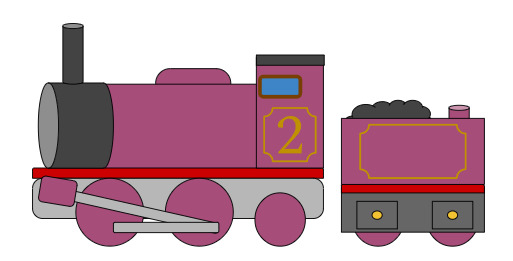
Norham - This guy never got a drawing. Norham is the leader of the Andrew-Barclay locomotives, and also the living embodiment of the nerd emoji. Krystal hates him until the two of them are perseved together and they're forced to talk with one another.
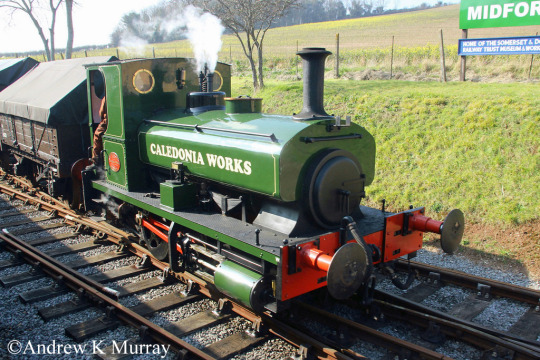
Bea - An 0-4-0 of unknown origin, Bea is the main and also only shunter of Bourenbouth Port. He's also level-headed like Marlow, but he has an affection for the eccentric. The Port closes alongside the Quarry, and Bea is left in his shed for years until Marlow remembers that he's there, and Bea is rescued and brought to the NRM in York, where he ends up fitting in quite well. (you get the weathered version too.)
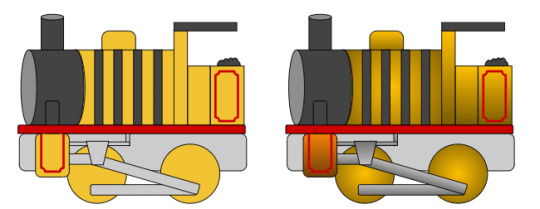
William - The main tugboat to interface with Bea and Marlow, William loves telling stories about the other boats in the area. (literally just "tugs refrences go here.") Aside from that, William is also fascinated with the Macabre, so some visiting engines find him best in small doses.
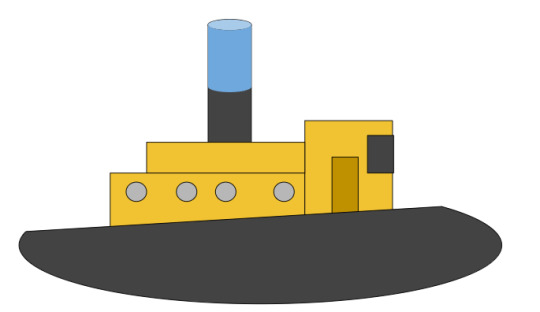
That's all of the important ones! Some others have drawings but aren't important, just background fillers for either side of the conflict. As a special thing, here is an old unfinished piece of Marlow & Kyd being pulled out of the river (featuring their old designs, and them being covered in rust and mud!) and the Out Of The River story in full! (It's not my best and if I ever rework it I think i'd just start from scratch anyways.)
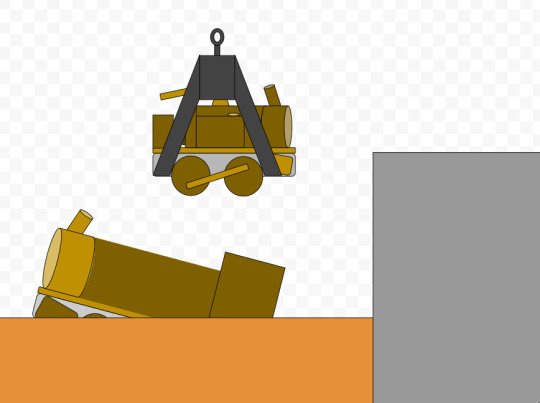
I hope you enjoy these guys, they are my Heritage Blorbos™.
#ttte#ttte oc#busted's oc posts#Marlow#Kyd#Out Of The River#god these guys are so old now lol#I still think about Marlow & Kyd to this day tho
2 notes
·
View notes
Text
the other night i had a dream that i went to see oppenheimer and barbie as a double feature with a group of people i didn't know but i guess was trying ro befriend? anyway oppenheimer started out as an episode of nbc hannibal thatbwas playing out like if hannibal had a post-series film (a la the x-files w i want to believe) and there was homosexual tenderness between hannibal and will but as soon as it turned to being about oppenheimer i got aggressively bored and fell asleep. in my dream. i awoke when it was time to change theatres to see barbie and we were now in an industrail warehouse type situation where everyone was being corralled like animals to a machine, we had assigned seating and they were patting us down for food and drinks because they were so concerned we'd be hiding cameras in our stuff that we weren't allowed to take anything in. you literally had to sit in a cafe area and eat off brand skittles and sprite if you wanted anything. anyway my group ditched me and i wound up taking residence outside the theatre doors like we were all at a convention and while i was waiting for the movie to start i took out my switch to try and fight calamity ganon who was now a bloodborne boss while the kid next to me gave me tips.
3 notes
·
View notes